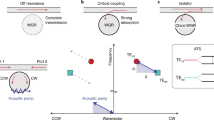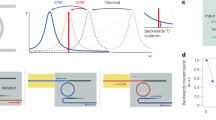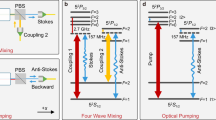Abstract
Motivated by the demands of integrated and silicon photonics, there is significant interest in optical isolators in on-chip integrated systems. Recent works have therefore explored nonlinear optical isolators and demonstrated non-reciprocal transmission contrast when waves are injected in forward or backward directions1,2,3,4,5,6,7,8. However, whether such nonlinear isolators can provide complete isolation under practical operating conditions remains an open question. Here, we analytically prove and numerically demonstrate a dynamic reciprocity in nonlinear optical isolators based on Kerr or Kerr-like nonlinearity. We show that, when a signal is transmitting through, such isolators are constrained by a reciprocity relation for a class of small-amplitude additional waves and, as a result, cannot provide isolation for arbitrary backward-propagating noise. This result points to an important limitation on the use of nonlinear optical isolators for signal processing and for laser protection.
This is a preview of subscription content, access via your institution
Access options
Subscribe to this journal
Receive 12 print issues and online access
$209.00 per year
only $17.42 per issue
Buy this article
- Purchase on Springer Link
- Instant access to full article PDF
Prices may be subject to local taxes which are calculated during checkout




Similar content being viewed by others
References
Fan, L. et al. An all-silicon passive optical diode. Science 335, 447–450 (2012).
Peng, B. et al. Parity–time-symmetric whispering-gallery microcavities. Nature Phys. 10, 394–398 (2014).
Chang, L. et al. Parity–time symmetry and variable optical isolation in active–passive-coupled microresonators. Nature Photon. 8, 524–529 (2014).
Wang, J. et al. A theoretical model for an optical diode built with nonlinear silicon microrings. J. Lightw. Technol. 31, 313–321 (2013).
Miroshnichenko, A., Brasselet, E. & Kivshar, Y. Reversible optical nonreciprocity in periodic structures with liquid crystals. Appl. Phys. Lett. 96, 063302 (2010).
Bender, N. et al. Observation of asymmetric transport in structures with active nonlinearities. Phys. Rev. Lett. 110, 234101 (2013).
Nazari, F. et al. Optical isolation via PT-symmetric nonlinear Fano resonances. Opt. Express 22, 9574–9584 (2014).
Fan, L. et al. Silicon optical diode with 40 dB nonreciprocal transmission. Opt. Lett. 38, 1259–1261 (2013).
Jalas, D. et al. What is—and what is not—an optical isolator. Nature Photon. 7, 579–582 (2013).
Fan, S. et al. Comment on ‘Nonreciprocal light propagation in a silicon photonic circuit’. Science 335, 38 (2012).
Iwamura, H., Hayashi, S. & Iwasaki, H. A compact optical isolator using a Y3Fe5O12 crystal for near infra-red radiation. Opt. Quantum Electron. 10, 393–398 (1978).
Shiraishi, K., Sugaya, S. & Kawakami, S. Fiber Faraday rotator. Appl. Opt. 23, 1103–1106 (1984).
Gauthier, D., Narum, P. & Boyd, R. Simple, compact, high-performance permanent-magnet Faraday isolator. Opt. Lett. 11, 623–625 (1986).
Shoji, Y., Mizumoto, T., Yokoi, H., Hsieh, I. & Osgood, R. Magneto-optical isolator with silicon waveguides fabricated by direct bonding. Appl. Phys. Lett. 92, 071117 (2008).
Tien, M., Mizumoto, T., Pintus, P., Kromer, H. & Bowers, J. Silicon ring isolators with bonded nonreciprocal magneto-optic garnets. Opt. Express 19, 11740–11745 (2011).
Bi, L. et al. On-chip optical isolation in monolithically integrated non-reciprocal optical resonators. Nature Photon. 5, 758–762 (2011).
Ghosh, S. et al. Ce:YIG/silicon-on-insulator waveguide optical isolator realized by adhesive bonding. Opt. Express 20, 1839–1848 (2012).
Yu, Z. & Fan, S. Complete optical isolation created by indirect interband photonic transitions. Nature Photon. 3, 91–94 (2009).
Kang, M. S., Butsch, A. & Russel, P. Reconfigurable light-driven opto-acoustic isolators in photonic crystal fibre. Nature Photon. 5, 549–553 (2011).
Lira, H., Yu, Z., Fan, S. & Lipson, M. Electrically driven nonreciprocity induced by interband photonic transition on a silicon chip. Phys. Rev. Lett. 109, 33901 (2012).
Doerr, C. R., Dupius, N. & Zhang, L. Optical isolator using two tandem phase modulators. Opt. Lett. 36, 4293–4295 (2011).
Doerr, C. R., Chen, L. & Vermeulen, D. Silicon photonics broadband modulation-based isolator. Opt. Express 22, 4493–4498 (2014).
Yu, Z. & Fan, S. Optical isolation based on nonreciprocal phase shift induced by interband photonic transitions. Appl. Phys. Lett. 94, 171116 (2009).
Fang, K., Yu, Z. & Fan, S. Photonic Aharonov–Bohm effect based on dynamic modulation. Phys. Rev. Lett. 108, 153901 (2012).
Tzuang, L., Fang, K., Nussenzveig, P., Fan, S. & Lipson, M. Non-reciprocal phase shift induced by an effective magnetic flux for light. Nature Photon. 8, 701–705 (2014).
Li, E., Eggleton, B., Fang, K. & Fan, S. Photonic Aharonov–Bohm effect in photon–phonon interactions. Nature Commun. 5, 3225 (2014).
Sounas, D. L., Caloz, C. & Alu, A. Giant non-reciprocity at the subwavelength scale using angular momentum-biased metamaterials. Nature Commun. 4, 2407 (2013).
Boyd, R. Nonlinear Optics 3rd edn (Academic, 2008).
Siegman, A. E. Lasers Ch. 29 (University Science Books, 1986).
Berenger, J. P. A perfectly matched layer for the absorption of electromagnetic waves. J. Comput. Phys. 114, 185–200 (1994).
Reinke, C. et al. Nonlinear finite-difference time-domain method for the simulation of anistropic, χ(2), and χ(3) optical effects. J. Lightw. Technol. 24, 624–634 (2006).
Gallo, K., Assanto, G., Parameswaran, K. R. & Fejer, M. M. All-optical diode in a periodically poled lithium niobate waveguide. Appl. Phys. Lett. 79, 314–316 (2001).
Huang, X. & Fan, S. Complete all-optical silica fiber isolator via stimulated Brilliouin scattering. J. Lightw. Technol. 29, 2267–2275 (2011).
Poulton, C. et al. Design for broadband on-chip isolator using stimulated Brilliouin scattering in dispersion-engineered chalcogenide waveguides. Opt. Express 20, 21236 (2012).
Acknowledgements
This work was supported in part by the US Air Force Office of Scientific Research (grant no. FA9550-09-1-0704) and the US National Science Foundation (grant no. ECCS-1201914). Y.S. also acknowledges the support of a Stanford Graduate Fellowship.
Author information
Authors and Affiliations
Contributions
Y.S., Z.Y. and S.F. designed the study and contributed to the analytic derivation. Y.S. wrote the numerical code and performed the simulation. Y.S. and S.F. wrote the manuscript with input from Z.Y., and S.F. supervised the project.
Corresponding author
Ethics declarations
Competing interests
The authors declare no competing financial interests.
Supplementary information
Supplementary information
Supplementary information (PDF 374 kb)
Rights and permissions
About this article
Cite this article
Shi, Y., Yu, Z. & Fan, S. Limitations of nonlinear optical isolators due to dynamic reciprocity. Nature Photon 9, 388–392 (2015). https://doi.org/10.1038/nphoton.2015.79
Received:
Accepted:
Published:
Issue Date:
DOI: https://doi.org/10.1038/nphoton.2015.79
This article is cited by
-
Electrically tunable VO2–metal metasurface for mid-infrared switching, limiting and nonlinear isolation
Nature Photonics (2024)
-
Heat-assisted nonreciprocity
Nature Photonics (2024)
-
Passive bias-free non-reciprocal metasurfaces based on thermally nonlinear quasi-bound states in the continuum
Nature Photonics (2024)
-
Directional terahertz holography with thermally active Janus metasurface
Light: Science & Applications (2023)
-
A self-biased non-reciprocal magnetic metasurface for bidirectional phase modulation
Nature Electronics (2023)



